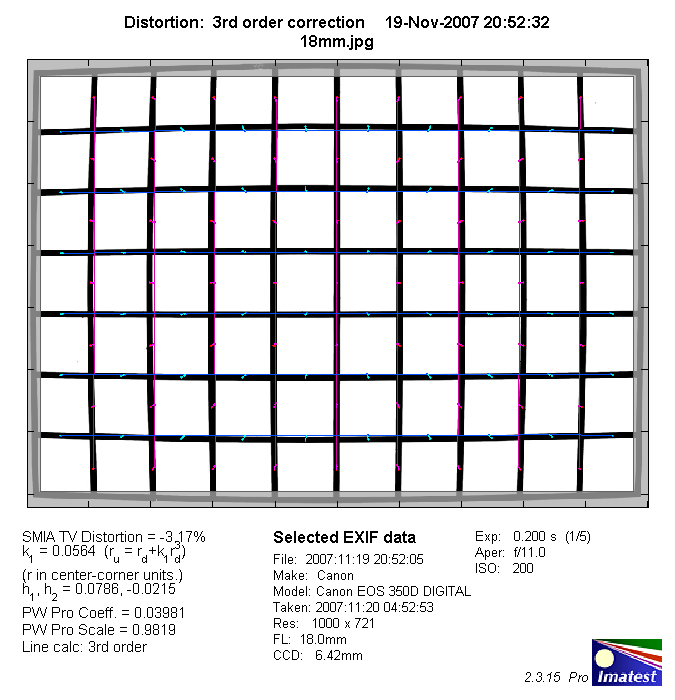|
Canon EF-S 18-55mm f/3.5-5.6 IS - Review / Test Report - Analysis |
|
Lens Reviews -
Canon EOS (APS-C)
|
|
Page 2 of 3

Distortion
Typical for many APS-C standard zooms the EF-S 18-55mm f/3.5-5.6 IS produces very strong barrel
distortion at 18mm (~3.2%) changing to very mild (~0.2%) pincushion distortion at 55mm.
|
Move the mouse cursor over the focal length text marks below to observe the respective distortions
|
| 18mm |
28mm |
55mm |

|
The chart above has a real-world size of about 120x80cm.
Vignetting
The Canon EF-S 18-55mm f/3.5-5.6 IS is a dedicated APS-C lens and these lenses tend to produce a
comparatively high degree of vignetting. At 18mm @ f/3.5 we're talking about ~1.35EV here which is
quite easily visible in many field images. The problem eases towards the
long end of the zoom range and it's generally not all that bad anymore at f/5.6 and a non-issue
beyond.

MTF (resolution)
Usually I'm doing the lab tests straight at the beginning of the testing procedure but the weather
was fine at the time (November tends to miserable here in Central Europe) so I took it into the
field first. I had to raise an eyebrow or two during the image browsing thereafter. In fact I
rechecked the EXIF data in order to make sure that the (very sharp) images were taken with this
lens - a member of the dreaded "kit" lens league after all. Well, enough chatting - let's
have a look at the resolution data obtained under lab conditions now ...
The center resolution of the lens is extremely high throughout the tested zoom and aperture
range and at its sweet spots it matches or exceeds the sensor resolution of the 8mp base DSLR
used for testing. Normally you would expect a severe drop off beyond the inner image portion
but this is not the case. The border and even the extreme corners remain on a very good level
especially at 18mm. This is not unprecedented - the Nikkor AF-S 18-55mm f/3.5-5.6 ED is also
darn good - but it's certainly something new for a budget Canon standard zoom lens. Rest assured
that you may not be the only one reading this in disbelief.
Please note that the MTF results are not directly comparable across the different systems!
Below is a simplified summary of the formal findings. The chart shows line widths per picture height (LW/PH) which can be taken as a measure for sharpness.
If you want to know more about the MTF50 figures you may check out the corresponding Imatest Explanations
Chromatic Aberrations (CAs)
The level of lateral chromatic aberrations (color shadows at harsh contrast transition) is varying
throughout the zoom range. At 18mm the CAs stay below 1px on the average at the image borders which
is surprisingly well controlled even when compared to higher priced standard zoom lenses. In the middle
range the CAs are quite significant (up to 1.5+ px) but the problem decreases again beyond.

|